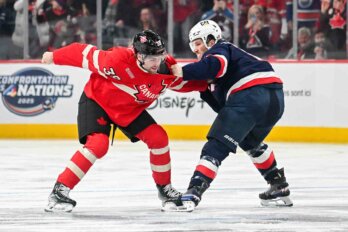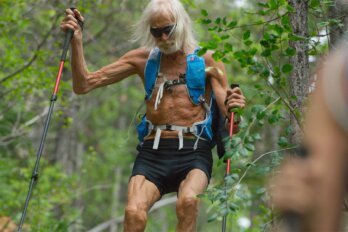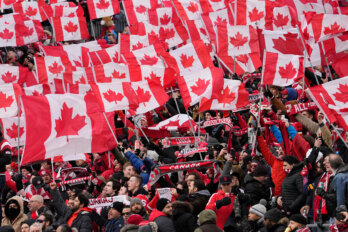Coming out is now such a widespread fact of life that it’s largely lost its controversial tinge. The act is reflected in songs, TV episodes, movies, magazine articles, funny tweets—there’s an entire cultural script. You congratulate the person. You wrap them in a hug. You say, “I knew all along.”
Things were different for New Brunswick teenager Yanic Duplessis, whose coming out drew national media attention. If he hadn’t been drafted by the Quebec Major Junior Hockey League’s Drummondville Voltigeurs in 2019, Duplessis’s revelation—made in an interview with the FDS Podcast Network—would be just another drop in queerness’s rising tide. But, since his hockey-playing rights are owned by a team in a major feeder league for the NHL, he made history by becoming the closest out LGBTQ player to the sport’s top league.
Duplessis, of course, is not the first male athlete to come out as gay or even the first one in a traditional team sport. A number of players in the rest of the big four North American sports leagues—basketball, football, and baseball—have done so, many after retiring; Michael Sam, an NFL prospect, came out before being drafted and ultimately never played a game in the league. In women’s hockey, meanwhile, a number of star players have come out to virtually no controversy. Yet, in men’s hockey, we have only Duplessis. As we enter the third decade of the twenty-first century, no NHL team has ever drafted a player who has come out as any stripe of queer.
Of course, if something like a public coming out has happened only a handful of times in the other team sports, it’s hardly surprising to see it fail to appear in hockey. Zero, after all, is not a much smaller number than one or two.
But any hockey fan who’s watched a 1–0 game is familiar with the vastness of that difference. It seems to me that there’s something about men’s hockey—a sport about which comedian Rodney Dangerfield once reportedly quipped, “I went to a fight last night and a hockey game broke out”—that’s especially unfriendly to queerness. Its core culture remains one of male aggression, where weakness of any kind, real or perceived, gets weaponized. I know what I’m talking about because I left hockey myself, largely over not being “manly enough.”
Mainstream culture may be getting increasingly comfortable with homosexuality, but hockey culture is not mainstream culture. Men’s hockey has always been an old boys’ club, an engine for reifying masculine physical sacrifice in the pursuit of glory, and an at-times-overt analogue for the military. However comfortable life becomes for queer people in the rest of society, in the bravado haze of hockey dressing rooms, it will continue to be agonizing for a long, long time.
Hockey is a perennial niche sport—it’s less watched, less played, and less well understood than basketball, football, and baseball—but it will always have this over its competitors: it’s tougher.
Last October, when handing out the 2020 Stanley Cup, NHL commissioner Gary Bettman called it the hardest championship win in all of sports: “The gauntlet that you have to run to hoist this trophy is unbelievable.” For starters, between the regular season and the playoffs, teams have to play between ninety-eight and 110 games to win the Stanley Cup; in the NFL, the only other genuine contact league of the big four, teams play about a fifth of that number.
Then there’s what happens on the ice. Witness the bone-shaking bodychecks, the slashes, collisions, and trips. Witness the bare-knuckle fighting, when the game stops so two players can duke it out, or the brawls, when everyone joins in, even those still on the bench. Hell, witness suit-and-tie-wearing coaches getting into altercations themselves.
Note the way suffering is valorized, the athletes who power through not just pain but debilitating injury: Bobby Baun’s broken-ankle overtime game-winner in 1964, Paul Kariya’s “Off the floor, on the board!” goal after returning from a devastating check to the head in 2003, Patrice Bergeron playing through a punctured lung in 2013—and those are just moments from the Stanley Cup finals. A YouTube comment on a video compilation of NHL players pushing through pain summed it up thusly: “Soccer players pretend they’re hurt, Hockey players pretend they aren’t.” The comment has over 1,000 likes.
So central to the sport is the endurance of pain that the most popular hockey podcast is called Spittin’ Chiclets—a jokey euphemism for players losing teeth during a game. The average hockey fan may think it’s odd to even bring this up, so ingrained is the mentality: hockey players play through pain because they’re real men, and real men aren’t pussies. Any deviation from the straight, white, masculine norm may see a player marked as one. At times, this policing veers into the absurd. In 2018, after his trade from the Calgary Flames, it was suggested that defenceman Dougie Hamilton wasn’t a team player because, according to rumours, he was the type of guy who visited museums on his days off.
In 2019, the Carolina Hurricanes caught heat from racist-grandpa-cum-TV-host Don Cherry when the team gathered on home ice to celebrate wins with coordinated dances. “This is the National Hockey League,” Cherry said of the Hurricanes’ celebratory “Storm Surges.” “They’re a bunch of jerks, as far as I’m concerned.” These criticisms didn’t necessarily represent mainstream hockey opinion, but they did occur in a culture that’s oppressively stifling when it comes to difference and flash, one where the banality of players’ interview responses (We’ve got to work hard, give it 110 percent, get pucks deep) is legendary.
The era of people like Cherry dogging European players for not measuring up to North American standards of toughness may be over, but within the past two or three years, it’s still been reasonable to publicly accuse—in coded hockey terms—straight men of not being straight enough. Players who don’t conform are saddled with nicknames like Sidney Crysby or the Sedin Sisters.
The game, of course, is not without its feminine elements. Hockey slang—as much as it celebrates the grind-it-out aspect of the game—can make use of a much more femme lexicon when describing certain plays: a player who stickhandles well has silky mitts, a good playmaker dishes passes with soft hands, and some dekes are so technically proficient they become beautiful. We watch hockey to see the bruisers brawl but also to see the phenoms dazzle.
Players, commentators, and fans often deal with that contradiction—between the aesthetic beauty of the sport and the innate toughness associated with it—by adding extra masculinity, like a sauce doled out too liberally to cover up an off taste in the dish below.
Me, I was always a pussy.
I came out as bisexual in my late teens and nonbinary in my early thirties, but people could tell that my last name was a misnomer long before I hit puberty. At school and at the rink, they didn’t hesitate to let me know.
Growing up in Westmount, Montreal’s richest neighbourhood, I played house league. It was nominally coed, but in the decade or so I spent ferrying my equipment to the rink and back, I recall seeing only two girls on the ice. What I remember more than anything, except the smell of the arena and the way raucous voices echoed in the cold air, was the unpleasantness of the boys around me in the dressing room. It worsened as we grew older, peaking during the one season I played in a more competitive league.
I was twelve that year. I didn’t know, then, that I wasn’t straight or that I wasn’t cis—I just knew, as my teammates told me, that I wasn’t manly. I was a goaltender, the game’s de facto position for weirdos and loners, where every mistake is tallied in the ledger of the scoreboard. I was a class outsider too. Though my parents could afford to live in Westmount’s less wealthy lower half, I was nowhere near as well off as many of the other players, typically scions of lawyers, business executives, and doctors. My parents didn’t own a car, which meant walking to a teammate’s house before every road game to carpool; most of my equipment was second-hand and none of it was high-end.
My experience reflects an unpleasant truth about the sport: it costs a lot of money to play. That financial barrier produces a community—both hockey’s fans and its elite player pool—that’s much more uniformly white than those of the other major North American sports. As Rachel Giese writes in Boys, registration in a competitive league can cost hundreds if not thousands of dollars per year; new equipment can cost hundreds if not thousands more, which requires ample disposable income. (That’s not factoring in travel costs for those playing in competitive intercity leagues; Montreal Canadiens goaltender Carey Price’s father famously bought a small airplane to ferry his son to and from games when he was growing up in remote Anahim Lake, BC.)
It’s hard to build a sport that’s accepting of otherness when you start from a base position of excluding the poor—and, in Canada and the US, racialized communities tend to have higher rates of poverty. Basketball, baseball, and soccer don’t have especially high barriers for entry—a ball and a hoop, a ball and a bat, or just a ball are all kids need. For hockey, every single player needs a stick and a pair of skates, not to mention a puck and an ice surface.
It’s not surprising, then, that hockey is blindingly white and relatively conservative, or that it often stumbles in its attempts to address that fact. Last year, several Black NHL players created the Hockey Diversity Alliance only to part ways with the league months later due to the NHL’s perceived failure to address their requests—which included funding for POC-focused grassroots programs and increased use of Black players in promotional materials, among other changes to make the game less exclusionary.
Statistically, hockey is a less predictable sport than its peers are. On any given night, grunt work can have a greater impact than superstar plays, elevating team-first self-sacrifice into dogma. In a culture that valorizes the group over the individual, any kind of difference can and will be weaponized. The toxicity can overflow in ways that are at times criminal, even monstrous.
Consider the pending lawsuit former NHLer Dan Carcillo brought against the Canadian Hockey League, where he played as a teen, about the sexual assaults (in the form of hazing) that he and other rookies had to endure. If rookie players—even those who are cis, straight, white, and normatively masculine—are considered viable targets for in-group/out-group cruelty, what hope do queer kids have of escaping the truncheon?
After one year of wearing the white-and-red Westmount Wings jersey, I didn’t make the team again. A few years of house league later, in my late teens, I decided to call it quits altogether. Hockey was still fun, still beautiful, still a contest of wits and wills and white-knuckle thrills. But that was on the ice. So long as hockey meant fraternizing with the kinds of boys who played hockey, smelling the acrid scent of their normative masculinity in the dressing room on either end of the game—well, I didn’t want to play it that badly.
The aggressive toxicity of hockey culture drove me away from the game I love. I’m not exaggerating when I say I miss it every day, that I daydream about buying all-new goalie equipment someday in the future (when my wallet can take the blow), suiting up, and slowly working my way up to more competitive leagues.
I still imagine what it would be like to be so good, so impenetrable, that they have to sign me to a pro contract despite the fact that, in my early thirties, I’m already older than half the league. I imagine TV announcers trying to wrap their minds around my use of they/them pronouns. Well, whatever you wanna call this kid—this guy—he, they—buddy—it—can sure stop the damn puck.
But, more than the raw facts of sexuality—the feelings of attraction to men, of being outside of full masculinity—there’s nothing mainstream hockey culture is so allergic to as queerness. Queerness as ethos, as an intentional going against the grain, not just feeling and wanting differently but living differently—this, hockey culture could never abide. If it cannot sit comfortably with P. K. Subban wearing flashy suits and being a proud Black man about town, if it cannot let a quiet Dougie Hamilton visit museums on his days off without snide commentary, how could it possibly handle queerness?
If ever there are out gay NHL players, I have to imagine they’ll be Pete Buttigieg types—practised not just in crossovers, head-fakes, and taking the body but also in the art of appealing to the mainstream. They’ll be in committed relationships, clean-cut and classically manly. Their teammates will say all the right things: It’s about the logo on your chest, not what happens in your bedroom; he’s a stand-up guy and that’s all I care about; gay, straight, bisexual—if he finishes his checks and blocks shots like the rest of us, then what do I care?
My favourite bit of NHL propaganda is a thirty-second promotional spot for the 2010 Stanley Cup finals. It’s ironic, given my disdain for the ways that hockey players are so often afraid to speak their minds.
Called “No Words,” it’s an interview montage of players from years past, fresh off winning the Cup, trying and failing to put the sensation into sentences. As a soft melody plays over the clips, we watch the men pause and stammer and swallow. One pinches the bridge of his nose; another stares upward, trying to will away tears.
It’s a beautiful, less-is-more revelation that achieving glory in this kid’s game is genuinely, unquantifiably meaningful for these men. In this moment of triumph, they’re reduced to shy little boys—a silence born not of caginess but of awe, the lessons about being a tough guy stripped away and replaced with a humanity that feels raw and tender. I cannot watch it without getting goosebumps.
The truth is, there has always been homoerotic desire in hockey, the way there is any time enough men gather together, like a sort of queer holy spirit. Whenever two or more gather in my name, I am there. It may not have been spoken aloud, acted on, or acknowledged, but it was there, the way queerness has always been, uninvited yet irrepressible.
As Pierre Lebrun wrote last November in The Athletic, in an article about the coming out of player agent Bayne Pettinger, Pettinger’s brother Matt thinks he “undoubtedly had a gay teammate at some point” during his NHL playing career. It’s hard not to believe him—almost 2,300 men played at least one game in the league over that ten-year period.
I imagine a player in the ’60s or ’70s—bushy moustache, sideburns, perhaps a goalie, like me—sitting in the dressing room for an older franchise. The Red Wings, maybe, or the Flyers: a meat-and-potatoes team. Silently carrying a truth he knows about himself as his teammates talk about their sex lives—wives, girlfriends, mistresses, so-called puck bunnies.
Putting on his jockstrap, his chest protector, his mask. Ready to go out and prove how tough he is all over again. How unafraid. How much a real man, in every sense of the word.



